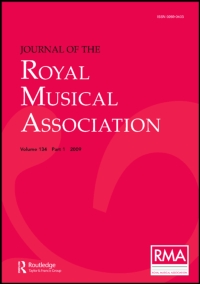No CrossRef data available.
Article contents
Giovanni Pierluigi, Da Palestrina
Published online by Cambridge University Press: 01 January 2020
Extract
For nearly three centuries the name of Palestrina has been much more familiar than his works, especially in England. Comparatively few English musicians—we may even say absolutely few—professional or amateur, can claim a practical acquaintance with the writings of this composer, whose name is so well-known to them. On the Continent things are a little better; but only, I believe, in Germany can the works of Palestrina be often heard. Of course difference of religion has some influence in causing the ignorance in England; the recent performance of “Missa Papæ Marcelli,”in St. Paul's Cathedral, was epoch-making indeed, and not the least important of the general events which have so marked the year 1898 as an era in the religious history of England. Since so little is publicly heard of Palestrina's works here, and no trustworthy account of his life has been published in English, as far as I am aware, a paper upon both life and works will hardly require an apology.
- Type
- Research Article
- Information
- Copyright
- Copyright © Royal Musical Association, 1898
References
∗ Authorities: the Cacilienkalender for 1879; the Kirchenmusikalisches Jahrbuch for 1886, 1890, 1892, and 1894.
∗ “Geschichte der Musiktheorie,” p. 301.Google Scholar
∗ See Morton Latham's “The Renaissance of Music,” chapter ii.Google Scholar
∗ Or just possibly 1525.Google Scholar
† The authority for Palestrina's biography is the tercentenary article in the Kirchenmusikalisches Jahrbuch, 1894, pp. 86–99.Google Scholar
∗ See the articles on Giles Tomkins and Christopher Tye in the “Dictionary of National Biography.”Google Scholar
† The documents are printed in Haberl's “Bausteine fur Musikgeschichte,” No. 3.Google Scholar
‡ The Registrar, elected annually. This office was in 1555 filled by a Spaniard.Google Scholar
∗ When Cardinal, he had been very active in promoting religious reforms, and also in patronising art.Google Scholar
∗ See Ranke's “History of the Popes.'Google Scholar
∗ Palestrina had taken Doralice's dowry on mortgage, pledging two houses and a vineyard in Rome.Google Scholar
† “Grove's Dictionary,” Art. “Palestiina.”Google Scholar
∗ A copy is preserved at BolognaGoogle Scholar
∗ See the most interesting study upon Ingegneri in the Kirchenmusiktlisches Jahrbuch for 1898. The Responses have since been edited in score from the printed part-books.Google Scholar
∗ See the bibliography in the Kirchenmusikalisches Jahrbuch for 1899.Google Scholar
† “Florilegium Sacrarum Cantionum Quinque Vocum.” Antwerp, 1609.Google Scholar
∗ Explained in Zacconi's “Prattica Musica.”Google Scholar
† A new part for the third choir has been composed by M. Haller, of Ratisbon Cathedral (Collected Edition, XXVI.).Google Scholar
∗ It may also be found, as “I will magnify Thee,” in the Motet Society's Publications and the Tonic Sol-fa Reporter, with several other adaptations from the motets and offertories.Google Scholar
† See Mendelssohn's Letters.Google Scholar
∗ The original meaning of a Passagio was a long florid division.Google Scholar
∗ See also Lassub's Magnum opus musicum, III., 51.Google Scholar
∗ Boyce omitted two in Byrd's “Bow Thine ear.”Google Scholar
† See also Seiffert's “Geschichte der Klaviermusik,” p. 29.Google Scholar
∗ Helmholtz's “Sensations of Tone” (ed. A. J. Ellis), p. 225.Google Scholar
∗ According to Haberl, extra accidentals are specially required in descending runs.Google Scholar
∗ Grove IV., 793. I find on reference that I was wrong in this matter. Rockstro had apparently not seen No. 3 of the “Bausteine.” He was quoting No. 2.—H. D.Google Scholar


